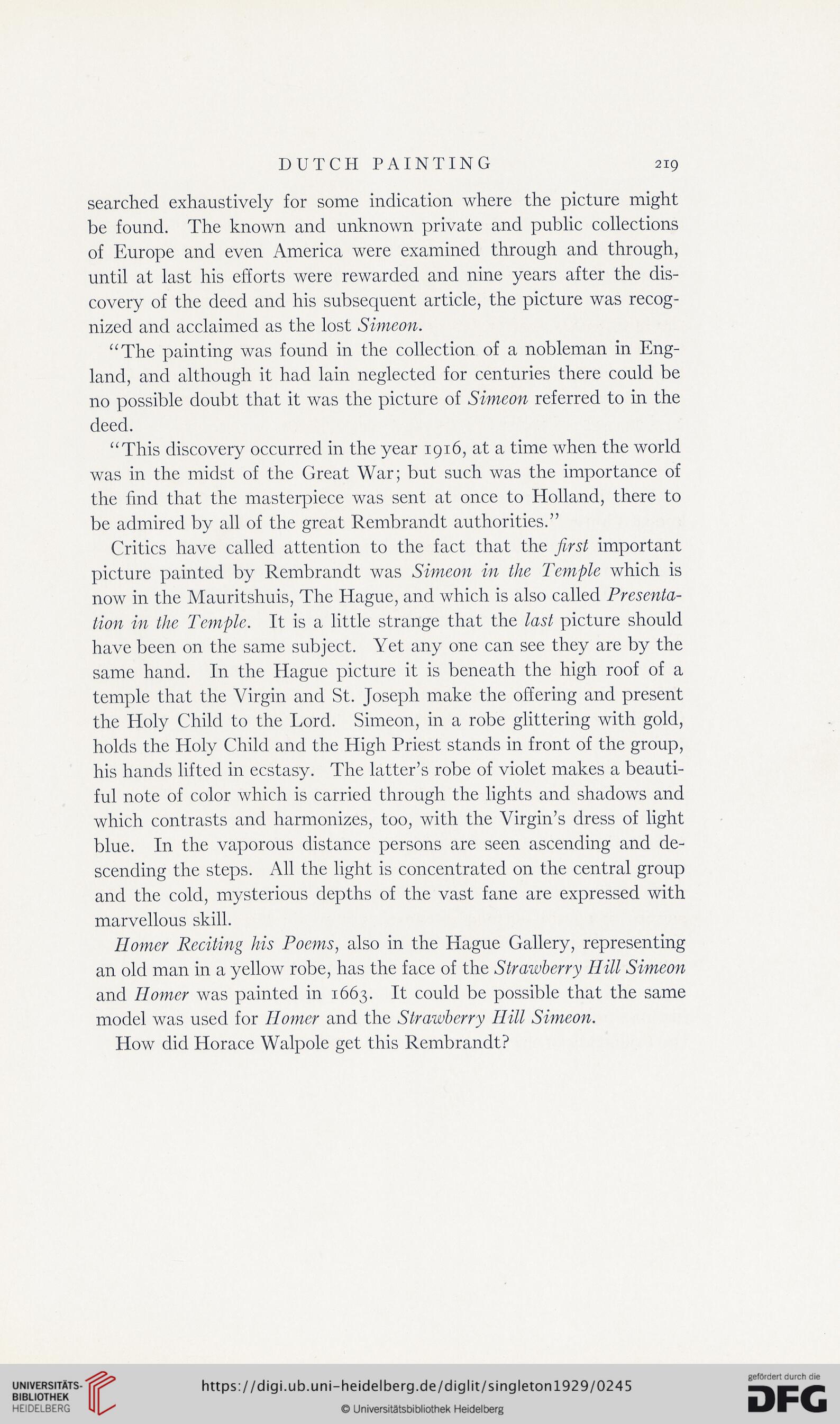DUTCH PAINTING
219
searched exhaustively for some indication where the picture might
be found. The known and unknown private and public collections
of Europe and even America were examined through and through,
until at last his efforts were rewarded and nine years after the dis-
covery of the deed and his subsequent article, the picture was recog-
nized and acclaimed as the lost Simeon.
“The painting was found in the collection of a nobleman in Eng-
land, and although it had lain neglected for centuries there could be
no possible doubt that it was the picture of Simeon referred to in the
deed.
“This discovery occurred in the year 1916, at a time when the world
was in the midst of the Great War; but such was the importance of
the find that the masterpiece was sent at once to Holland, there to
be admired by all of the great Rembrandt authorities.”
Critics have called attention to the fact that the first important
picture painted by Rembrandt was Simeon in the Temple which is
now in the Mauritshuis, The Hague, and which is also called Presenta-
tion in the Temple. It is a little strange that the last picture should
have been on the same subject. Yet any one can see they are by the
same hand. In the Hague picture it is beneath the high roof of a
temple that the Virgin and St. Joseph make the offering and present
the Holy Child to the Lord. Simeon, in a robe glittering with gold,
holds the Holy Child and the High Priest stands in front of the group,
his hands lifted in ecstasy. The latter’s robe of violet makes a beauti-
ful note of color which is carried through the lights and shadows and
which contrasts and harmonizes, too, with the Virgin’s dress of light
blue. In the vaporous distance persons are seen ascending and de-
scending the steps. All the light is concentrated on the central group
and the cold, mysterious depths of the vast fane are expressed with
marvellous skill.
Homer Reciting his Poems, also in the Hague Gallery, representing
an old man in a yellow robe, has the face of the Strawberry Hill Simeon
and Homer was painted in 1663. It could be possible that the same
model was used for Homer and the Strawberry Hill Simeon.
How did Horace Walpole get this Rembrandt?
219
searched exhaustively for some indication where the picture might
be found. The known and unknown private and public collections
of Europe and even America were examined through and through,
until at last his efforts were rewarded and nine years after the dis-
covery of the deed and his subsequent article, the picture was recog-
nized and acclaimed as the lost Simeon.
“The painting was found in the collection of a nobleman in Eng-
land, and although it had lain neglected for centuries there could be
no possible doubt that it was the picture of Simeon referred to in the
deed.
“This discovery occurred in the year 1916, at a time when the world
was in the midst of the Great War; but such was the importance of
the find that the masterpiece was sent at once to Holland, there to
be admired by all of the great Rembrandt authorities.”
Critics have called attention to the fact that the first important
picture painted by Rembrandt was Simeon in the Temple which is
now in the Mauritshuis, The Hague, and which is also called Presenta-
tion in the Temple. It is a little strange that the last picture should
have been on the same subject. Yet any one can see they are by the
same hand. In the Hague picture it is beneath the high roof of a
temple that the Virgin and St. Joseph make the offering and present
the Holy Child to the Lord. Simeon, in a robe glittering with gold,
holds the Holy Child and the High Priest stands in front of the group,
his hands lifted in ecstasy. The latter’s robe of violet makes a beauti-
ful note of color which is carried through the lights and shadows and
which contrasts and harmonizes, too, with the Virgin’s dress of light
blue. In the vaporous distance persons are seen ascending and de-
scending the steps. All the light is concentrated on the central group
and the cold, mysterious depths of the vast fane are expressed with
marvellous skill.
Homer Reciting his Poems, also in the Hague Gallery, representing
an old man in a yellow robe, has the face of the Strawberry Hill Simeon
and Homer was painted in 1663. It could be possible that the same
model was used for Homer and the Strawberry Hill Simeon.
How did Horace Walpole get this Rembrandt?




